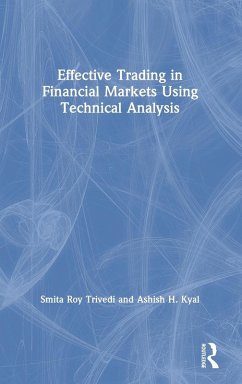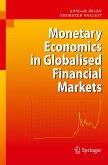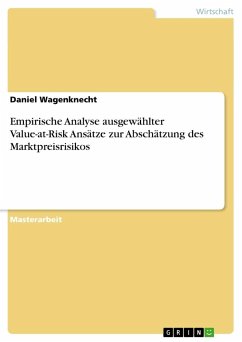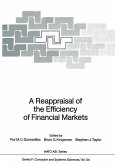This book provides a comprehensive guide to effective trading in the financial markets through the application of technical analysis through the following: Presenting in-depth coverage of technical analysis tools (including trade set-ups) as well as backtesting and algorithmic trading Discussing advanced concepts such as Elliott Waves, time cycles and momentum, volume, and volatility indicators from the perspective of the global markets and especially India Blending practical insights and research updates for professional trading, investments, and financial market analyses Including detailed examples, case studies, comparisons, figures, and illustrations from different asset classes and markets in simple language The book will be essential for scholars and researchers of finance, economics and management studies, as well as professional traders and dealers in financial institutions (including banks) and corporates, fund managers, investors, and anyone interested in financial markets.
Hinweis: Dieser Artikel kann nur an eine deutsche Lieferadresse ausgeliefert werden.
Hinweis: Dieser Artikel kann nur an eine deutsche Lieferadresse ausgeliefert werden.
'Investors ignore technical analysis near the end of bull markets, when buy and hold is in vogue. Today the approach is at a nadir of interest, just when people need it most. Get ahead of the next rush to understand and apply technical analysis. In their comprehensive overview, Roy Trivedi and Kyal first introduce you to the key terms of financial markets and then elucidate all established aspects of the technical analysis field. If you start with this book, you will have a foundation for deciding the next step to take in expanding your knowledge.'
Robert R. Prechter, Elliott Wave theorist, author and co-author of 14 books, including Elliott Wave Principle, and Conquer the Crash (New York Times best seller, 2002)
'There are lots of books about technical analysis available, but almost all of them are written by practitioners. Thus, a collaboration of academic and practitioner, as seen in this book, is rare but welcome. The lacking interest of academics in technical analysis is driven by the wide acceptance of the efficient market hypothesis. It seems very intuitive that financial market actors trade on the information available to them and that this leads to adjusted prices. Any other behavior would be irrational. Moreover, such behavior would be punished by future price developments of financial prices so that these markets reinforce rational behavior.
Seen from this perspective, the price of a financial asset depends on its future returns, discounted by interest rates and considering its riskiness. The role of fundamental analysis is then trying to learn about these determinants. In this world, there is no role for technical analysis. What should we learn from looking backwards if the price is only determined by future developments? At least this is the world of finance as it should be in principle. In reality, however, we know that markets are imperfect. This book rightly discusses in its Chapter 1, imperfections which may "justify" the use of technical analysis. Overall, there are good theoretical and empirical reasons why technical analysis can be a useful tool to forecast financial market developments (e.g., Hsu et al., 2016). However, as is true for fundamental analysis, the use of an analytical tool - and technical analysis is such a tool - requires expertise. This book provides some academic background in the beginning and then introduces and explains the main concepts of technical analysis. The presentation is clear and applied, providing many examples and also links to programming. Thus, I highly welcome this book which contributes to compile and spread expertise on technical analysis in financial markets.'
Lukas Menkhoff, head of department, International Economics, DIW Berlin (the German Institute for Economic Research)
'Those who dismiss technical analysis as unscientific have to confront the long and consistently profitable track records of legendary traders such as Linda Raschke. Whether you are studying technical analysis as a skeptic or a believer, Roy Trivedi and Kyal's book will serve as a comprehensive guide. The chapter on algorithmic trading is particularly helpful to those who plan to implement technical analysis in an automated program.'
Ernest P. Chan, author of Quantitative Trading, Algorithmic Trading: Winning Strategies and Their Rationale, and Machine Trading: Deploying Computer Algorithms to Conquer the Markets
'In the last four decades, "Technical Analysis" (TA) has become an important tool in the hands of analysts, researchers and practitioners in any financial /commodity markets. While fundamental analysis continues to be the mainstay of traditional market analysts, advent of technology has made the role of TA as important as that of fundamental analysis, if not more.
Given this trend, I feel that the book on TA by Smita and Ashish will be a very handy guide to any intending market specialist. The USP of this book is that it helps the reader in climbing up the learning curve on the subject in a smooth glide path but at the same time, without compromising on the thoroughness. Starting from the basic principles, the book traverses through a large canvas which includes study of patterns (reversal and continuation), candlesticks, moving averages, momentum, volume, and volatility indicators and finally concludes with a glimpse of algorithmic trading. The authors employ a very simple and lucid style to explain even difficult concepts with appropriate illustrations. I am sure the book will evoke an enthusiastic response from the readers.'
G. Mahalingam, whole time member, Securities and Exchange Board of India, and former executive director, Reserve Bank of India
'This book is an amazing toolkit to understand trading/investing as a data-driven science. The toughest act in money making is the art of keeping emotions aside, and this book explains the calibrated techniques and tools in a simplified manner.'
Kamlesh Jain, MRICS, CA, founder, Innovation India in and the Attention Institute, and former executive director, Nomura, head of Global Equities
'The timing of this book's publication - amid the global COVID-19 financial crisis of 2020 - is perfect for introducing a new generation to the value of technical analysis. The chapter on Elliott waves provides a solid review of the basic principles of wave analysis using recent examples and easy-to-understand summaries of important points. Long-term investors who read this book will be well prepared for the next secular bear market. And short-term traders will gain a quick return on the time invested in reading it.'
Mark Galasiewski, chief equity analyst for Asia and Emerging Markets, Elliott Wave International
'Smita and Ashish have put together a comprehensive piece of work on how to effectively use technical analysis (TA) in today's financial markets. The book is thoroughly researched, and a lot of references and credits are made to academic studies and well-respected technical analyses by authors throughout. They start with laying out the groundwork and foundations of financial markets and trading (infra) structure, especially in India, before even touching on analyses techniques which give the reader a solid foundation for understanding the TA concepts further on.
The main part of the book on TA, covers the most important and popular approaches in the field. Starting with various charting formats, then moving on to more subjective analyses tools like trends, price patters, indicators and even Elliott Wave, to finish with more quantitative tools and rules-based trading using tools like Excel and Python.
Although the majority of examples and explanations are geared towards the Indian markets, the language of technical analysis is universal. I recommend this book for every aspiring Technical Analyst who wants to get a solid understanding of the general TA framework and the various technical analysis tools that the authors discuss.'
Julius de Kempenaer, senior technical analyst at Stockcharts.com, director of RRG Research, and the creator of Relative Rotation Graphs(R)
Robert R. Prechter, Elliott Wave theorist, author and co-author of 14 books, including Elliott Wave Principle, and Conquer the Crash (New York Times best seller, 2002)
'There are lots of books about technical analysis available, but almost all of them are written by practitioners. Thus, a collaboration of academic and practitioner, as seen in this book, is rare but welcome. The lacking interest of academics in technical analysis is driven by the wide acceptance of the efficient market hypothesis. It seems very intuitive that financial market actors trade on the information available to them and that this leads to adjusted prices. Any other behavior would be irrational. Moreover, such behavior would be punished by future price developments of financial prices so that these markets reinforce rational behavior.
Seen from this perspective, the price of a financial asset depends on its future returns, discounted by interest rates and considering its riskiness. The role of fundamental analysis is then trying to learn about these determinants. In this world, there is no role for technical analysis. What should we learn from looking backwards if the price is only determined by future developments? At least this is the world of finance as it should be in principle. In reality, however, we know that markets are imperfect. This book rightly discusses in its Chapter 1, imperfections which may "justify" the use of technical analysis. Overall, there are good theoretical and empirical reasons why technical analysis can be a useful tool to forecast financial market developments (e.g., Hsu et al., 2016). However, as is true for fundamental analysis, the use of an analytical tool - and technical analysis is such a tool - requires expertise. This book provides some academic background in the beginning and then introduces and explains the main concepts of technical analysis. The presentation is clear and applied, providing many examples and also links to programming. Thus, I highly welcome this book which contributes to compile and spread expertise on technical analysis in financial markets.'
Lukas Menkhoff, head of department, International Economics, DIW Berlin (the German Institute for Economic Research)
'Those who dismiss technical analysis as unscientific have to confront the long and consistently profitable track records of legendary traders such as Linda Raschke. Whether you are studying technical analysis as a skeptic or a believer, Roy Trivedi and Kyal's book will serve as a comprehensive guide. The chapter on algorithmic trading is particularly helpful to those who plan to implement technical analysis in an automated program.'
Ernest P. Chan, author of Quantitative Trading, Algorithmic Trading: Winning Strategies and Their Rationale, and Machine Trading: Deploying Computer Algorithms to Conquer the Markets
'In the last four decades, "Technical Analysis" (TA) has become an important tool in the hands of analysts, researchers and practitioners in any financial /commodity markets. While fundamental analysis continues to be the mainstay of traditional market analysts, advent of technology has made the role of TA as important as that of fundamental analysis, if not more.
Given this trend, I feel that the book on TA by Smita and Ashish will be a very handy guide to any intending market specialist. The USP of this book is that it helps the reader in climbing up the learning curve on the subject in a smooth glide path but at the same time, without compromising on the thoroughness. Starting from the basic principles, the book traverses through a large canvas which includes study of patterns (reversal and continuation), candlesticks, moving averages, momentum, volume, and volatility indicators and finally concludes with a glimpse of algorithmic trading. The authors employ a very simple and lucid style to explain even difficult concepts with appropriate illustrations. I am sure the book will evoke an enthusiastic response from the readers.'
G. Mahalingam, whole time member, Securities and Exchange Board of India, and former executive director, Reserve Bank of India
'This book is an amazing toolkit to understand trading/investing as a data-driven science. The toughest act in money making is the art of keeping emotions aside, and this book explains the calibrated techniques and tools in a simplified manner.'
Kamlesh Jain, MRICS, CA, founder, Innovation India in and the Attention Institute, and former executive director, Nomura, head of Global Equities
'The timing of this book's publication - amid the global COVID-19 financial crisis of 2020 - is perfect for introducing a new generation to the value of technical analysis. The chapter on Elliott waves provides a solid review of the basic principles of wave analysis using recent examples and easy-to-understand summaries of important points. Long-term investors who read this book will be well prepared for the next secular bear market. And short-term traders will gain a quick return on the time invested in reading it.'
Mark Galasiewski, chief equity analyst for Asia and Emerging Markets, Elliott Wave International
'Smita and Ashish have put together a comprehensive piece of work on how to effectively use technical analysis (TA) in today's financial markets. The book is thoroughly researched, and a lot of references and credits are made to academic studies and well-respected technical analyses by authors throughout. They start with laying out the groundwork and foundations of financial markets and trading (infra) structure, especially in India, before even touching on analyses techniques which give the reader a solid foundation for understanding the TA concepts further on.
The main part of the book on TA, covers the most important and popular approaches in the field. Starting with various charting formats, then moving on to more subjective analyses tools like trends, price patters, indicators and even Elliott Wave, to finish with more quantitative tools and rules-based trading using tools like Excel and Python.
Although the majority of examples and explanations are geared towards the Indian markets, the language of technical analysis is universal. I recommend this book for every aspiring Technical Analyst who wants to get a solid understanding of the general TA framework and the various technical analysis tools that the authors discuss.'
Julius de Kempenaer, senior technical analyst at Stockcharts.com, director of RRG Research, and the creator of Relative Rotation Graphs(R)







